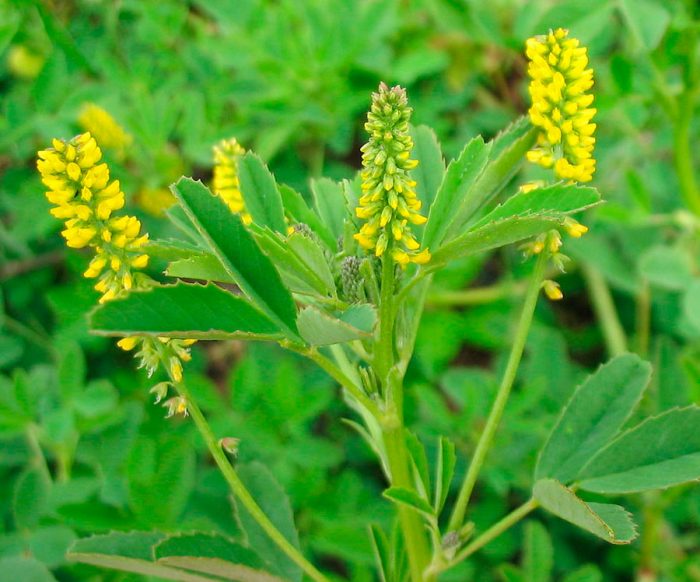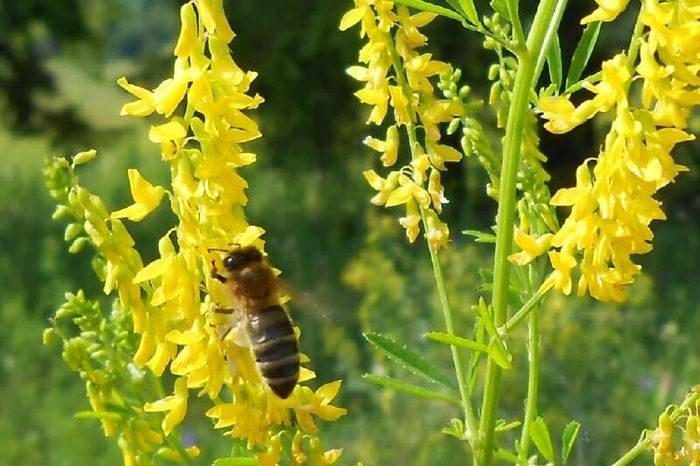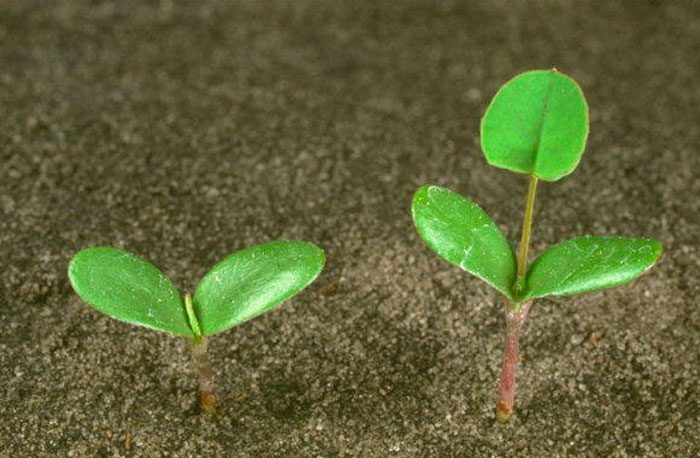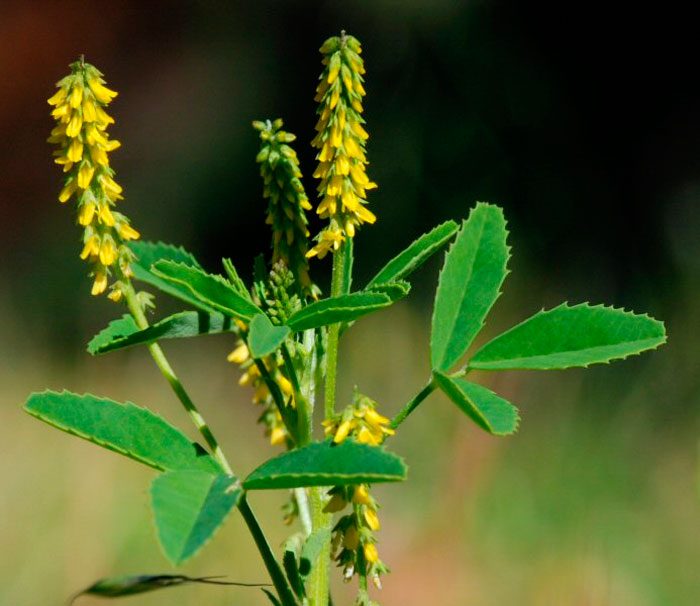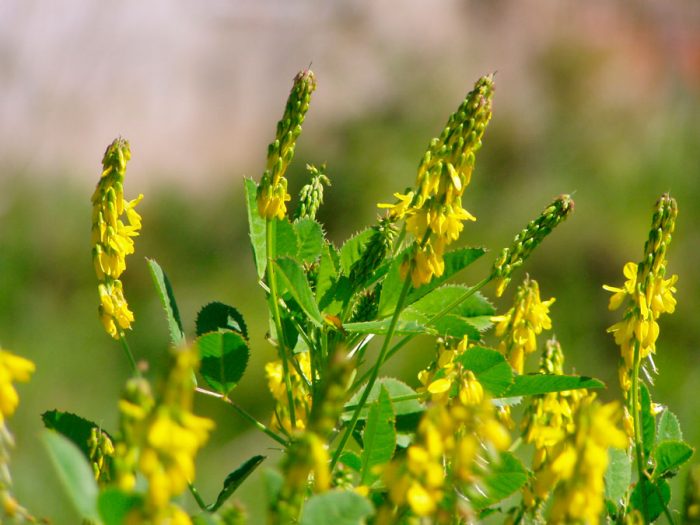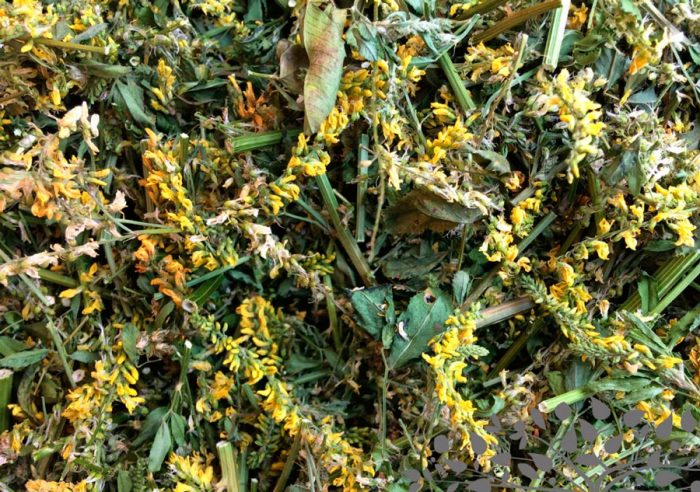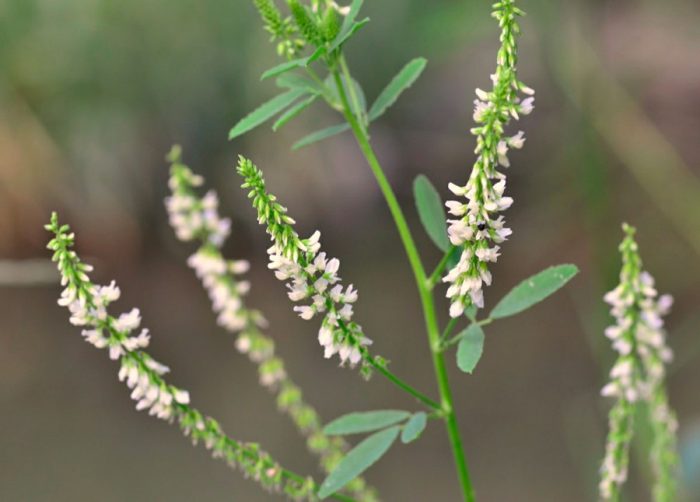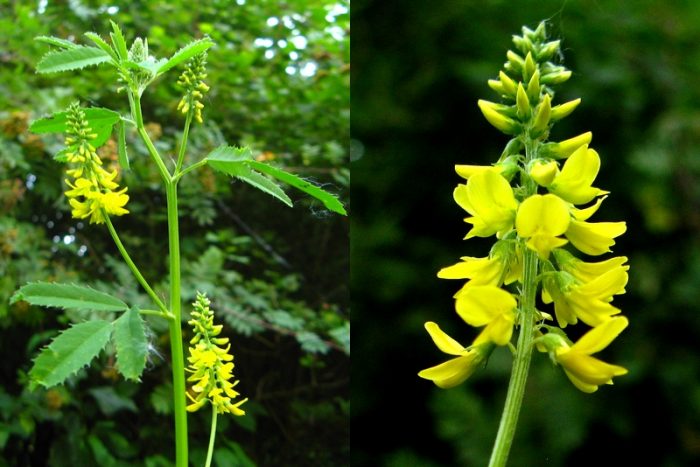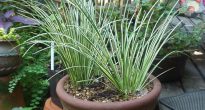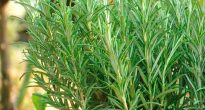The herbaceous juvenile plant Melilotus is a member of the Legume family. Melilot is a valuable green manure and fodder plant, while it has been in culture for more than two thousand years. Some of the species of this culture are grown as plants with medicinal properties. This plant is popularly called burkun, bottom grass and sweet clover. In nature, sweet clover is found in Asia and Europe; it prefers to grow on wastelands, meadows and fallow lands. This herb has a specific smell.
Content
Features of sweet clover
The height of the branchy stem of the sweet clover can vary from 0.5 to 2 meters. Taproot. The leaf plates are trifoliate (which looks like a clover), they consist of toothed leaves. The apical loose elongated brushes consist of small flowers of a yellow or white color. The fruit is a naked pod with a rounded shape, and reaches a length of 30-40 millimeters. The seeds remain viable for a relatively long time, or rather, for 14 years.
Melilot is grown as a green manure, because it improves the structure of the soil and saturates it with a substance such as nitrogen. It is also grown as a fodder plant, because it forms a nutrient biomass, which contains a very large amount of vitamins. This biomass is distinguished by fattening and milk-driving action. Also, this herb, which has a pleasant smell of fresh hay, is widely used for aromatizing soap, for flavoring tobacco, and in the perfumery industry it is used to fix the aroma. This plant is one of the best honey plants. From the nectar collected from the flowers of such a culture, white or amber honey is obtained, which has a very pleasant vanilla aroma.
Melilot cultivation
Landing in open ground
Only a small number of types of sweet clover are cultivated, while white clover and yellow clover are the most popular among gardeners. This culture is propagated, as a rule, by seed (generative) method. Melilot is not very demanding on the composition of the soil.This herbaceous plant grows well on black soil, solonetz, weakly podzolic and calcareous soil. But in no case should it be planted in acidic soil, as well as in swampy areas, where groundwater lies close enough to the soil surface.
Melilot has the ability to accumulate nitrogen, as well as extract nutrients from poorly soluble soil compounds, as a result of which it is able to grow and develop well even on poor or depleted soil. When choosing a site for planting, it is imperative to take into account that of the large number of legumes, this culture has the greatest photophilousness, so the site should be open and sunny.
Before planting, the site should be carefully prepared. To do this, it is obligatory to dig it with the introduction of phosphorus and potassium fertilizers, so 50 grams of superphosphate and 20 grams of potassium salt are taken per square meter.
The seeds of this plant are hard-stone, which greatly complicates the appearance of seedlings. Therefore, 20-30 days before sowing, they must be scarified. To do this, you need to pass the seeds two or three times through the clover graters. For these purposes, you can also use specially designed scarifiers.
Sowing seeds in open soil is recommended in April or May. For this, not very deep grooves are first made in the moistened soil, while the distance between them should be from 0.45 to 0.6 meters. After the seeds are sown in open ground, the grooves need to be sprinkled with a not very thick layer of soil, after which the surface of the site is carefully compacted. Sowing seeds that have not been pre-scarified, experienced gardeners advise, to produce them in winter, or rather, in February or January, they are simply scattered over the surface of the soil or snow cover. The rains in spring, as well as melt water, soften the strong seed coat, as a result of which the seedlings appear on the soil surface even when the temperature rises to 2–4 degrees. In the southern regions, the sowing of sweet clover seeds in open soil is usually done in August.
Sweet clover care in the garden
If the seeds are sown in the garden in the spring, the first seedlings will appear after about half a month. During the formation of a pair of true leaf plates, it is necessary to thin out the plants, and also carry out weeding, removing all weeds, while carefully loosening the soil surface between the rows. The recommended distance that should be left between the bushes in a row is 0.3 meters, but this does not apply to the case when this plant is grown as a green manure.
Melilot has a very high drought tolerance, in this regard, it is not necessary to systematically water such a crop. However, it must be fed in a timely manner; for this, phosphorus and potash fertilizers are introduced into the soil.
In the first year of growth, no fruits are formed on the sweet clover bushes, this is because they have an intensive development and growth of the root system. Since the root collar of the melilot in winter is in open soil, in this regard, with the onset of the spring period, it is necessary to ensure that the site is not flooded with melt water during the melting of the snow cover. During flowering, this culture attracts a large number of bees, which collect its nectar. It produces excellent honey, distinguished by its high taste and medicinal qualities.
Diseases and pests
Melilot, like almost all agricultural crops, is susceptible to a variety of diseases, and a variety of pests that damage the plant can also settle on it.Most often, this plant is affected by powdery mildew, ascochitosis, peronosporosis, bacteriosis of roots, septoria and yellow mosaic. As a rule, bushes are affected by fungal diseases only when they are grown in conditions that are not quite suitable for a given culture. It is recommended to treat diseased plants with a fungicide solution as soon as possible, for example, Fundazol, Maxim, Bordeaux liquid, Abiga-Peak, etc. When a sweet clover is affected by a mosaic, its bushes should be removed from the soil as soon as possible and must be destroyed so that this disease does not continue to spread throughout the garden plot. The fact is that such a disease is not amenable to treatment today.
This plant can accommodate such pests as: various kinds of bugs and weevils: clover, red alfalfa and yellow seed-eaters; leafy, nodular and large alfalfa weevils; melilot and bristly nodule weevils; green palomen; cabbage, rapeseed, herbal, alfalfa and mustard bugs; edge and camptopus bordered; wingless redbird; stenodema prickly; ruled, berry and spring cormorants. In order to get rid of such harmful insects, experts advise using systemic insecticides, for example, such as: Actellik, Aktaru, Karbofos or other agents that have a similar effect. For the purpose of prevention, it is imperative to follow the rules of crop rotation, do not forget to weed the area in a timely manner, and do not be lazy to process the soil and seed immediately before sowing. Also, in the spring and autumn, in order to prevent, the site should be treated with insecticides. If everything is done correctly, then the pests will bypass the sweet clover and will not be able to harm it.
Not only an experienced, but also a novice gardener will be able to grow such a culture on his garden plot. If you follow all the rules of agricultural technology of this culture and properly care for it, then problems with the sweet clover should not arise at all.
Collection and storage of sweet clover
Experts advise harvesting sweet clover during its flowering. To do this, using scissors or secateurs, it is necessary to cut off all lateral shoots, as well as the apical racemose inflorescences. The resulting medicinal raw materials must be tied into not very large bundles, which should be suspended from the ceiling in a dry and well-ventilated room, where they can dry very well. For these purposes, you can also use an electric dryer, while the temperature on it should be set to 40 degrees, no more, no less. After the shoots are completely dry, they will need to be thoroughly threshed. Then the resulting mass of medicinal raw materials must be sieved using a sieve made of wire, which will remove large pieces of stems that need to be thrown away. Foliage, small shoots, fruits and flowers of sweet clover possess medicinal properties, which have a coumarin smell and a bitter-salty taste. To store the dried sweet clover, use tight-fitting containers made of ceramics or glass. The medicinal raw material of sweet clover should be stored in a dark and dry place.
Types and varieties of sweet clover with photos and names
Among gardeners, only two types of sweet clover are most popular. Detailed descriptions will be given below. Some of their varieties, which are also often grown in garden plots in various regions, will also be described.
White sweet clover (Melilotus albus), or burkun, gunba, gunoba, male sweet clover, verkin grass
The height of this biennial plant can vary from 0.3 to 1.5 meters. This pasture and silage culture has feathery leaf plates, stipules with subulate shapes, as well as axillary inflorescences consisting of white moth-type flowers.This honey plant differs from others in that it produces nectar even during a prolonged dry period, while the bees fly to the melilot, because they are attracted by the rather pleasant aroma of hay. In the wild, this culture can be found in Belarus, Kazakhstan, Siberia, Ukraine, Moldova, Central Asia and the Caucasus. It prefers to grow on slopes, along the edges of fields and roads, in ravines and dry wastelands. The following varieties of white sweet clover are cultivated by gardeners:
- Medet... This early maturing plant is related to the Siberian ecotype. The height of the bush can vary from 1.1 to 1.2 meters. The shoots of medium thickness are rather coarse. Long, narrow racemose inflorescence consists of large white flowers. This variety is highly resistant to drought, frost, it is also salt-resistant, and it is not afraid of any diseases and harmful insects, so there will be no problems with its cultivation.
- Frost... This plant has good bushiness. Bare shoots with medium coarseness are colored green. The bare trifoliate leaf plates are green in color and have a slightly serrated edge. The elongated loose racemose inflorescence is multiflorous and consists of white flowers. The beans are elliptical. The plant is highly resistant to powdery mildew, but it is susceptible to damage by weevils.
- Chermasan... The height of this early ripening plant is about 200 centimeters. Shoots are rough, and there is no pubescence on their surface. The length of the medium-sized inflorescences is about 18 centimeters, they include white flowers. The dark gray beans are elliptical in shape.
- Steppe... This early ripening variety is characterized by high drought tolerance and high yield. Coarse straight shoots are short pubescent in the upper part, and glabrous in the lower part. The stem height can vary from 1.45 to 1.7 meters. Tripartite leaf plates of a rounded shape have a serrated edge. They are greenish glabrous, and there is a thin waxy coating on their surface. Axillary racemose inflorescence is loose. The fruit is a two-seeded or one-seeded elliptical bean, which is colored in a yellow-straw color.
- Volzhanin... This variety is distinguished by its salt tolerance, yield and drought tolerance. It is resistant to powdery mildew and is not afraid of return frosts observed in spring. The bush is erect, not leaning. The height of the average coarseness of branchy shoots can vary from 1.65 to 2.5 meters. Fruits are single-seeded or double-seeded beans of dark gray color. The yellow seeds are oval in shape.
Also, gardeners often cultivate the following varieties of this type of sweet clover, namely: Lucerne 6, Srednevolzhsky, Povolzhsky, Obsky giant, Om, Sayansky, Sretensky, Meshchersky 99, Rybinsky, Nemyugunsky, Bulat, Diomid, etc.
Yellow sweet clover (Melilotus officinalis), or medicinal sweet clover, or medicinal sweet clover
Among the people, this species is still quite often called burkovina, vargun, wild hop, wild buckwheat, bottom, hare chill, sticky, groundwort and molar grass. In the wild, this type of sweet clover is found in Belarus, Western Siberia, Ukraine, Central Asia and the Caucasus. Such sweet clover prefers to grow among shrubs, on forest edges, in young plantings, along fields and roads, along ravines and in meadows. This biennial herb has a taproot that has a very large number of branches. The height of the straight stem varies from 150 to 200 centimeters, in the lower part it is lignified. The triple alternate leaf plates have long petioles and green-gray serrate-toothed leaflets along the edge, which have an oblong-ovoid shape.Multi-flowered racemose inflorescences, reaching from 50 to 70 millimeters in length, consist of flowers of a yellow color. The fruit of this type of sweet clover is a transversely wrinkled pod, which is colored brown. Inside the beans are smooth oval-shaped seeds, colored brown-yellow or yellow, they fully ripen in August or September. The most popular among gardeners are varieties of yellow sweet clover, such as:
- Sarbas... This variety is mid-season, it has a high yield, as well as resistance to drought and frost. This variety shows active growth and development in spring. After this grass is mown, it grows back relatively quickly. Such a sweet clover is highly resistant to powdery mildew, and harmful insects that damage seeds do not settle on it.
- Koldybansky... This variety is drought tolerant. The bush of such a sweet clover is weak. The shoots are quite rough and can vary in height from 0.8 to 1.2 meters. The seeds are relatively small. This variety is one of the best honey plants.
- Ishim early. This frost-resistant plant is distinguished by its resistance to salt and drought. It is early ripening and has a high yield. This herb is resistant to powdery mildew, and also to all pests that damage seeds. This erect bush reaches a height of about 0.8 meters, its bushiness is average.
- Kokshetau... It is a drought-resistant and salt-tolerant plant with frost resistance, capable of producing a rich harvest of green mass. Its nectar produces honey of the highest quality.
- Omsk... This early ripening plant has flowers painted in a yellow color. Two-seeded beans are relatively large in size.
Sweet clover properties: harm and benefit
Useful properties of sweet clover
The herbaceous plant sweet clover contains cymarin, tannins and fat-like substances, essential oil, flavonoids, ascorbic acid, carotene, tocopherol, sugars, mucus and glycosides; in the process of their splitting, coumarin is obtained, which is a crystalline substance with a rather pleasant aroma of hay ...
The fact that this plant has medicinal properties became known to people a long time ago, even in ancient times. This herb is distinguished by expectorant, hypotensive, anti-inflammatory, antibacterial, anticoagulant, fibrinolytic, emollient, diaphoretic, carminative, anticonvulsant, wound healing and sedative effect. The drugs created on the basis of the medicinal clover are used in the treatment of bronchitis, hypertension, constipation, hysteria, migraine, insomnia, rheumatoid and gouty arthritis, cough, dropsy, atherosclerosis, flatulence, neurasthenia, increased nervous excitability, diffuse toxic goiter, and also their used for purulent wounds, inflammation of the genital organs in women, abscesses and boils.
Honey, which was obtained from the nectar of sweet clover, also has medicinal properties. It is widely used for diseases of the upper respiratory tract, insomnia, neuroses, high blood pressure, pain in the head, as well as for diseases of the joints and varicose veins. This delicious and incredibly healthy honey also stimulates lactation. This honey also has a mild laxative and diuretic effect.
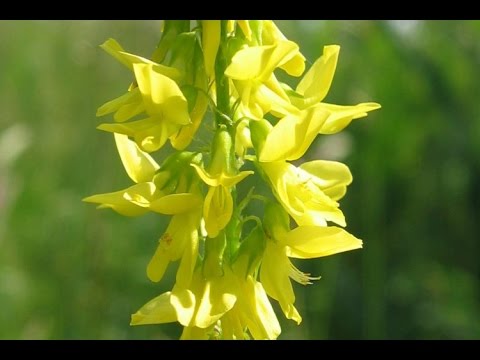

Watch this video on YouTube
Who is contraindicated sweet clover
Donnik, as well as all preparations made on its basis, should not be used by pregnant women, as well as by people suffering from kidney disease. It is very important to remember that this plant contains toxic substances, in this regard, the dosage should be strictly observed.If the clover is used in very large volumes, then it has an extremely negative effect on smooth muscles, and also contributes to the depression of the nervous system. If such drugs are used for a rather long time, then because of this, drowsiness, nausea, pain in the head area, vertigo and vomiting may develop. In some cases, subcutaneous internal hemorrhage occurs, liver damage, and also paralysis of the central nervous system. In this regard, such drugs should be used only as directed by the attending doctor, who must select the required dosage. And do not forget to be sure to strictly observe this dosage.

